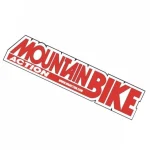MONGOOSE, GT AND•MILLYARD?
Story and photos by Ryan Cleek
I recently spent a few days at Bootleg Canyon in Boulder City, Nevada, riding test bikes you’ll see in upcoming issues. And, also squeezed in some downhill runs on my racebike, built up with some new ’08 components. The volcanic terrain of Bootleg is so unique and technical, that should a bike have a weakness in design or componentry, it inevitably stands out.
Upon pulling into the parking lot, I saw some familiar faces from Mongoose and GT, such as, Mongoose team mechanic John Canepa, Mongoose Director of Product Development Darren Salsbury, Mongoose team rider Steve Romaniuk, and GT R&D Manager Robert Stemen. They were riding prototype 2009 downhill bikes, and a carbon fiber all-mountain bike. Among the people I recognized, there were a couple of unfamiliar faces. However, once I saw the very distinct downhill bikes they were riding (and heard their accent), I realized they were Allen and Stephen Millyard, the father and son duo known for their innovative gearbox bike from the UK.

Although, anxious to jump on my bike after the five hour drive from Santa Monica to Las Vegas, I left my gear in the car, and poked around a bit with why the GT, Mongoose and Millyard crews were sharing a shuttle truck. Could there be some collaboration in the works? Maybe the next generation of GT’s IT 1 gearbox bike? 
“I guess you kind of caught us with our pants down today,” said GT’s Robert Stemen jokingly.
“We’re just out here riding, that’s all,” said Mongoose’s Darren Salsbury with a sly grin.
“I can say we’re impressed with how their gearbox works, but I’m more interested in their shock technology at this time,” said Stemen.
(After hearing this, I quickly sent a text message to Eric Carter (who couldn’t make the trip to Bootleg because he was sick with pneumonia); to ask him how he liked his new gearbox downhill bike, just to see his reaction…)
On a whole, the GT and Mongoose guys were pretty tight-lipped about doing downhill runs with the Millyard crew. Which, I can’t blame them for not wanting to show their hand if something big is in development.Unfortunately, shortly after I arrived the Millyard duo split for the airport to catch a flight home. I did, however, take the opportunity to score an in-depth look into the 2009 Mongoose Boot’R downhill bike.
There will be a few different price points available; the Boot’R shown here features one of the more affordable component specs.
2009 MONGOOSE BOOT’R
“The frame testing has gone really well so far,” says Mongoose Director of Product Development, Darren Salsbury. “We use our team riders Eric Carter, Steve Romaniuk and Andrew Neethling to help in the bike’s development, and it’s also fun to get our here and beat on them ourselves.”
Mongoose wanted to bring the look of their Khyber six-inch-travel freeride bike to their entire gravity line. The tubing style of the Khyber will be applied to the new Mongoose Pinn’R freeride bike and the Boot’R downhill bike, so the six, seven and eight-inch bikes will all share a similar look. The Boot’R will replace the ECD downhill bike next year.
BOOTE’R SPECIFICS
– The Boot’R frame weighs 8.5 pounds, a tad lighter than the ECD at 8.8 pounds.
– In order to increase stiffness, durability and reduce weight, the frame’s upper pivots were changed from 10-millimeter to 17-millimeter oversized 7075 alloy axles. The bearing was also size increased from 25-millimeter to 30-millimeter.
– The lower pivots moved up from 8-millimeter to 10-millimeter bolts, and the bearings moved from inside the linkage to outboard for improved stiffness.
– The stays are more robust in diameter, to keep the rear triangle more laterally stiff.
– The ECD and Black Diamond bikes currently use 73-millimeter bottom bracket shells with wide spindles to accomplish the desired chainline. The Boot’R will have an 83-millimeter bottom bracket shell to match up better with the 150-millimeter rear end. 
– Very few people used the ECD’s multiple travel options. So the new frame was designed around a single shock mount with 8.25 inches of travel. The leverage beginning and ending leverage ratios of the FreeDrive suspension were designed to provide supple small bump compliance, yet maintain superb pedaling performance.
– The arcing wheel path moves the rear wheel backwards as it moves upwards, intended to tame square-edge impacts.




